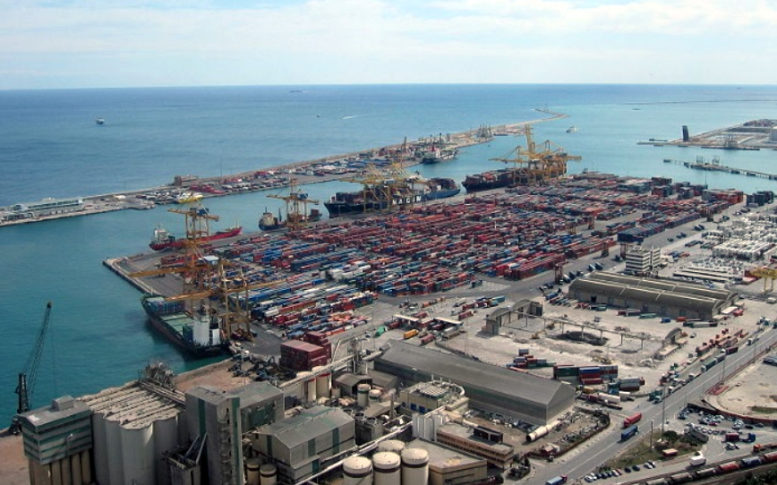In 2017, the Port of Barcelona recorded its best results yet in the main traffic indicators, figures that allowed it to take a quantum leap to become the fastest-growing European port. Total traffic (including all cargo modes) surpassed 61 million tons for the first time, recording a year-on-year increase of 26%.
This result contributed significantly to the excellent behavior of container traffic, one of the most strategic segments of activity for the Port and also a more representative marker of the surrounding economy. Nearly 3 million TEUs were moved in 2017, an increase of 32.3%. A very significant factor in this increase was transhipment containers (+137%), which are those unloaded from one ship to be reloaded onto another for final shipment. Although this activity does not impact directly on the economy of the Port’s surrounding economy, it does help to make stowage operations more competitive and to provide greater connectivity for the region’s importers and exporters.
Containers for Foreign Trade. Containerized import cargo stood at 561,103 TEU (+8.3%) and export cargo (the most significant in volume terms, at 705,204 TEU) was up 2.6%. These figures also indicate a significant degree of recovery compared to pre-crisis levels. Reactivation of traffic in export containers had already begun in 2010, but it is worth noting that in 2017 the Port of Barcelona channeled 68% more of this type of cargo than in 2007. Last year, the all-time record for import containers established in 2007 was surpassed for the first time. Specifically, the Catalan port channeled 3% more import containerized cargo than it did 10 years ago. China continues to be Port of Barcelona’s prime trading partner, both in terms of imports (44.3% of foreign trade containers unloaded in the Catalan facility), and exports (since it receives 11.6% of the containers leaving the Port). The remaining trading partners of the Port, and type of products channeled, are highly diversified.
Liquid Bulk Transport. 14.4 million tons of goods were transported (mainly hydrocarbons), an increase of 27% year on year. There was growth in specific products: natural gas (+64%), gasoline (+30%), and chemicals (+23%).
Dry Bulk. 4.4 million tons of goods were handled, or an increase of around 1%, soya beans (+10%), and cereals and meal (+13%), a most positive development.
UTI and Goods transported to the Balearic and Canary Islands, and freight travelling on the motorways of the sea. The Port channeled 393,601 intermodal transport units (UTI) of Ro-Ro traffic (truck, platform or trailer), marking an increase of 6.2%. Barcelona channeled a total of 144.723 UTI (+7%) via the motorways of the sea (or short sea shipping services), resulting in an identical number of trucks diverted from the road to the maritime mode, which is more efficient both economically and environmentally. Traffic on the motorways of the sea also hit a new record for the Port and contributes significantly to boosting sustainable logistics chains in the Mediterranean area.
Vehicles. During 2017 the Port of Barcelona channeled a total of 837,273 vehicles, down 8.7% year on year. Spanish vehicle production and exports also declined last year, which can be seen in the Port’s vehicle traffic results. Even so, Barcelona remains the leading port within the Spanish port system in terms of movement of vehicles.
More cruise passengers in winter, fewer in summer. For the first time, the Port of Barcelona moved 4.1 million people, comprising ferry passengers (1.4 million) and cruise-goers (2.7 million). The number of passengers increased by 4.5%, caused mainly by the increase in ferry passengers (+12%). Cruise passenger numbers increased by 1%. In the “low” season (January, February, March, November, December), cruise passenger numbers were up 13%, while in the remaining months there was a decrease of 2%.
Economic results. In 2017, net turnover was €167 million, up 7% year on year, due mainly to increased revenue from the upturn in activity. At the provisional close of the financial year, the Port recorded a profit of €50 million (+50%). The Port’s ability to generate cash flow was up 15% from the previous year’s €99. In 2017, the Port of Barcelona managed to cut significantly the long-term debt contracted with the European Investment Bank (EIB). It reduced its debt by 8%, which now stands at €281.1 million. Regarding the consolidated economic results (Port of Barcelona, CILSA, World Trade Center Barcelona and Port Vell), net turnover amounted to €215.6 million (+8%), while profits stood at €58.4 million (+45%).
